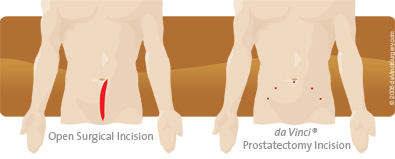Robotic prostatectomy or robotic-assisted laparoscopic prostatectomy is the complete surgical removal of the prostate gland and seminal vesicles. The procedure is performed laparoscopically using the da Vinci Surgical System. The da Vinci Surgical System provides our USLV robotic surgeons, Dr. Joseph Trapasso and Dr. John Maggioncalda, with better vision, access, and better "hands" through the use of advanced optics and computer and robotic technology.
How is a Robotic Prostatectomy Performed?
The procedure is begun by inflating the abdomen with carbon dioxide gas in order to provide the surgeon with "working room". Next, six small incisions, 1/4 to 1/2 inch in length, are made in the abdomen and plastic or metal ports are installed to keep the incisions open. Seated at the da Vinci System console nearby and using both the laparoscopic surgical instruments and a pencil-sized video camera, the surgeon directs the da Vinci's robotic arms to dissect the prostate gland and adjacent tissue. The video camera's 12x magnification and 3D view enable the surgeon to identify the many delicate nerves, tiny blood vessels, and other structures surrounding the prostate gland. Once the procedure is completed and the prostate is removed, the patient awakens, is ambulating later that day and typically is discharged within 24-48 hours.

What Advantages does Robotic Prostatectomy Offer?
Robotic prostatectomy, which has been shown to be as effective as conventional procedures in treating localized prostate cancer, offers these advantages:
Patient Benefits
For qualified candidates, the robotic prostatectomy offers several potential benefits over the traditional open prostatectomy, including:
- Shorter hospital stay
- Less post-operative pain and pain medication
- Less anesthesia
- Less blood loss and transfusions
- No blood donation necessary from patient
- Less scarring
- Fewer postoperative complications than open surgery including fewer post operative infections
- Faster and more complete recovery of our patients, 50% go home the day after surgery. By comparison, time in the hospital for patients treated with open radical prostatectomy is two to three days.
- Quicker return to normal daily activities
- Most patients return to work two to three weeks after the procedure and resume exercising or golf in 3-4 weeks, recovery time for patients treated with radical open prostatectomy is six to eight weeks.
- The catheter that drains the bladder is removed after 10-14 days in robotic surgeries. In open radical prostatectomies, the catheter is removed after two to three weeks
- Covered by all insurance plans
- Costs the same as traditional open surgery
Surgeon Benefits
The da Vinci Surgical System used at Lehigh Valley Hospital for robotic prostatectomy extends our surgeons' capabilities to provide these significant benefits:
- 3-D Visualization: Provides the surgeon with a true 3-dimensional view of the operating field. This direct and natural hand-eye instrument alignment is similar to open surgery with "all-around" vision and the ability to zoom-in and zoom-out.
- Dexterity: Provides the surgeon with instinctive operative controls that make complex minimally invasive surgical procedures feel more like open surgery than laparoscopic surgery.
- Surgical Precision: Permits the surgeon to move instruments with such accuracy that the current definition of surgical precision is exceeded.
- Access: Surgeons can perform these complex surgical maneuvers in body sites, formerly with limited access, through 9-mm ports, eliminating the need for large debilitating incisions.
- Range of Motion: EndoWrist© Instruments restore full range of motion and ability to rotate instruments more than 360 degrees through tiny incisions.
- Reproducibility: Enhances the surgeon's ability to repetitively perform technically precise maneuvers such as laparoscopic suturing and dissection.
What Are the Side Effects of Robotic Prostatectomy?
Side effects associated with robotic prostatectomy, which are similar to those associated with open radical prostatectomy, include:
- Urinary incontinence
Stress incontinence is the term given to the leakage of urine that can occurs when a patient coughs, sneezes, or lifts a heavy object after the procedure. Typically, patients wear urinary pads or underwear liners after the procedure; most patients are able to discontinue them by three months; 85% by six months; and 95% by one year. At USLV, we have incorporated a specially designed urinary control recovery regime, utilizing biofeedback techniques prior to and after robotic prostatectomy, which expedites return to normal function. - Erectile dysfunction
Recovery of erectile function is dependant upon several factors and varies based on the patient’s age, whether one or both nerves were spared, and what the patient's pre-surgical level of erectile function is. However, because of the unparalleled access, magnification, and gentleness of the daVinci robotic prostatectomy technique, a nerve-sparing procedure can most often be performed more precisely with, "the robot," than with the sole laparoscopic or traditional open approach.
